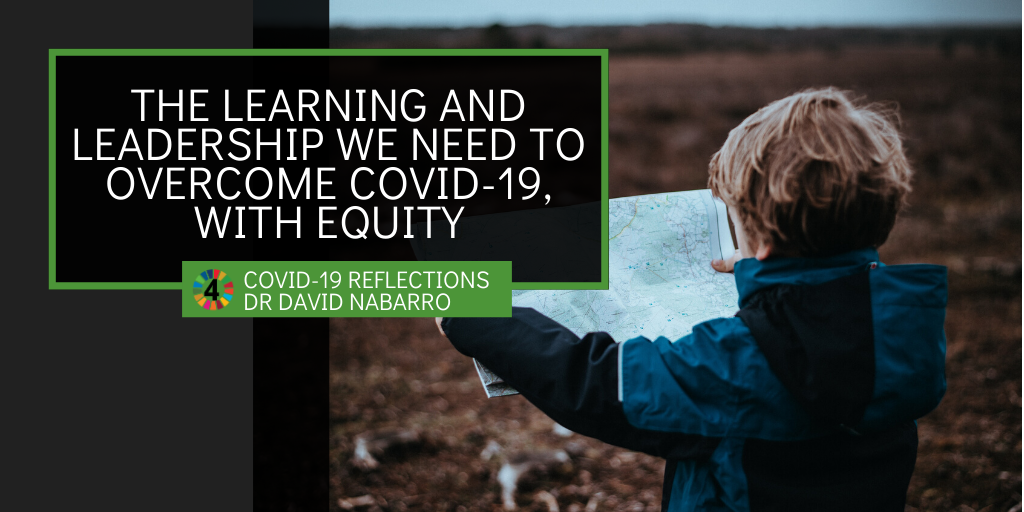10/06/2020: By Dr David Nabarro
One hundred days ago on 2 March, 90 percent of the 88.9k reported cases of the novel-coronavirus were within China, 4.7 percent in South Korea, and the death toll was 3,043.[1] COVID-19 had been declared by the World Health Organization (WHO) as a Public Health Emergency of International Concern weeks earlier and I was quickly shifting gear into my role as one of the WHO Director-General’s Special Envoys on COVID-19 Preparedness and Response.
I was also sharing my first Narrative which provided an insight into China’s response, and stressed then that nations had a window of opportunity to get ready, as early data suggested that the while the virus was only in a limited number of countries, it was on its way to spreading worldwide. Readiness makes a huge difference in public health, and I highlighted the need to work together seamlessly to achieve this readiness. I wrote:
“Those of us who have been responsible for outbreak responses have learned that we have to make a point of working together in ways that recognize our interdependence and reflect our respect for each other. This applies regardless of who we are, the nation we come from and our affiliations. We have learned that we do best if we are willing to share what we know (and do not know) openly with each other and do all we can to ensure that no person, no community and no nation is left behind.”
Today, though circumstances have changed dramatically, this message is just as relevant. We must never stop learning. Over 7 million cases of COVID-19 and 400,000 deaths have been reported[2] from almost every country in the world. We are facing major challenges in South Asia, Africa, Middle East and Latin America where communities and governments struggle to contain outbreaks with limited resources. The virus is particularly hard to contain in low-income, dense settlements or in places where people work in close quarters with poor ventilation. In many situations people are unable to implement physical distancing to protect themselves and others against infection and may have no option but to go on working even if feeling unwell.
Impact of lockdowns
The governments of many low- and middle-income countries acted as soon as they detected people with COVID, restricting people’s movements so as to limit opportunities for transmission of the virus. And in these countries, the rate of increase in numbers of cases spread was slowed substantially. Some have implemented lockdowns: while these have been in place national authorities have worked hard to communicate about COVID with their people and to encourage dialogue about the changes that must be made to prevent spread. They have built up community-level capacity to stop chains of transmission and organized public health services as best they can to contain new outbreaks rapidly.
Understandably, the governments that imposed lockdowns want to end them as quickly as possible because of their impact on people’s employment, food, nutrition and more. Few nations have the logistical systems and finance needed to provide social protection for hundreds of millions of people who have quickly become poorer and food insecure as a result of the limitations.
Stress on the economy and society
The ongoing damage to people’s wellbeing and economies is extremely serious. Under lockdowns, we saw unemployment increase rapidly and both small and medium enterprises in many sectors are facing bankruptcy. This will have major and far reaching impacts in the coming months: it is important that this evolving social and economic tragedy is quickly averted with imaginative and generous support from the international community including via the International Monetary Fund and development banks.
Limited health services
Health services in poor countries are struggling without essential equipment; health workers are getting ill; and people are finding that treatment for non-COVID illness is hard to find. There are distressing reports in this vein from many countries, and I read that in some places, health personnel are striking because they do not have the protective equipment that they need.
Critical capacity at the local level
Many low- and middle-income countries are emphasizing the need to establish well organized and rapid-reaction local public health capacity despite resource limitations. Great efforts are being made in many countries like India, Ethiopia, Ghana and many more. These countries took COVID seriously from the start. There has been rapid learning in South Africa where the lock-down was quickly supplemented by effective community engagement: this approach mirrors what was successful during the Ebola response in West Africa 2014-2015. However, many of these countries are extremely dependent on the World Health Organization, working closely with other UN actors including the Office for the Coordination of Humanitarian Affairs (OCHA) and the World Food Programme (WFP), which are also resource constrained as the COVID crisis continues in parallel with other, ongoing crises.
In European and North American countries whose governments have implemented evidence-based strategies consistently across different levels (e.g. federal/state/county), including well-organized local-level public health systems, communities are getting on top of the virus. There will still be outbreaks but with concerted and committed investment in strengthening public health capacity it should be possible to contain them quickly. There will still be challenges in high risk settings like residential care for older people.
Vulnerable groups
Persons on low incomes, in occupations that involve being in close contact with large numbers of people (e.g. transport personnel, cleaners, security staff and food workers), tend to be at particular risk. Often those who are suffering the most are from Black, Asian, minority ethnic and marginalized communities.
Equitable access
As there is increasing emphasis on developing vaccines and treatments, we should maintain focus on the need for equitable distribution and the importance of avoiding these assets just going to those with wealth and privilege. Because, as I repeat, we are only as strong as the weakest of us.
Now looking ahead, we must remain creative, innovative and do the best we can with what we have. New evidence and success stories are arriving every day. The new WHO guidance on face protection is a great example of the need to shift as we learn. I will continue to play my role in interpreting what this and many other evolving issues mean in practice. And I will keep emphasizing the importance of living systems leadership in the new COVID-Ready world and celebrating those who are doing this well.
Living systems leadership is the kind of leadership that encourages adaptive and coordinated local action, that prioritizes the needs of those who are less advantaged, and this is the leadership the world needs today, in every village, in every town, in every country.
[1] WHO Situation Report, 2 March 2020 https://www.who.int/docs/default-source/coronaviruse/situation-reports/20200302-sitrep-42-covid-19.pdf?sfvrsn=224c1add_2
[2] WHO Situation Report, 9 June 2020 https://www.who.int/docs/default-source/coronaviruse/situation-reports/20200609-covid-19-sitrep-141.pdf?sfvrsn=72fa1b16_2

